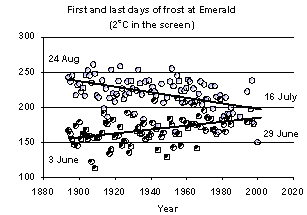Scientists from Australia’s leading climate research centres
are urging farmers to accept the reality of climate change and
to work collaboratively on farming systems that will cope with
more El Ninos and a range of other challenging climatic factors.
They say continuing increases in the concentration of carbon
dioxide in the atmosphere will have positive and negative effect
on the growth patterns of crops, trees and pastures while
changes in rainfall patterns – increases as well as increases –
will impact directly on production.
Temperature increases are already leading to changes such as
the planting dates for wheat; the period when frost can be
expected in Emerald, in Central Queensland, has dropped from
around 10 weeks in 1900 to around three weeks in 2000.
They say further temperature increases will also affect
rotations, limiting canola’s spread north into Queensland, for
instance, or encouraging cotton production further south than it
is grown now.
Water figures largely in the scientists’ calculations – river
flows, erosion and management of salinity. And crop management
is likely to see many changes, with farmers in what are now the
more favoured cropping regions perhaps learning from their
counterparts already farming in marginal environments.
In turn farmers who are in marginal regions now might switch
from their current grain/grazing mixed operations to pure
grazing or even plantation forestry.
 Joint
authors of the paper are Holger Meinke and Roger Stone from
QDPI/APSRU and Queensland’s Centre for Climate Applications
respectively, CSIRO researchers Mark Howden and Roger Gifford
and William Wright, from the Bureau of Meteorology in Melbourne.
Joint
authors of the paper are Holger Meinke and Roger Stone from
QDPI/APSRU and Queensland’s Centre for Climate Applications
respectively, CSIRO researchers Mark Howden and Roger Gifford
and William Wright, from the Bureau of Meteorology in Melbourne.
Their collaborative research has had the financial backing of
the Australian Greenhouse Office, the Grains and Cotton Research
and Development Corporations, CSIRO and Queensland’s Department
of Primary Industries. The work also had close links with
international scientists through the Asia-Pacific Network for
Global Change Research and United Nations and United States
programs.
Dr Meinke presented the paper at the Fifth Australian Maize
Conference in Toowoomba last week, telling delegates world
scientific opinion – the Inter-governmental Panel on Climate
Change (IPCC) – backed the reality of "greenhouse" gases and
resultant global warming.
The IPCC believed that – without new, countering initiatives
– globally averaged surface air temperature would warm by 1.5 to
6.0º C by 2100 relative to 1990.
A 1ºC rise in average temperature would make Melbourne’s
climate more like that currently experienced by Wagga Wagga, a 4ºC
rise like that of Moree and a 6ºC rise like that of
Roma.
|
"Climate change is already
affecting Australian cropping systems and the way we manage
them, although in many cases we might not be aware that we
are dealing with manifestations of climatic change." Dr
Meinke said.
" For example, the number of frost days and the dates of
last frost across most of Australia have reduced
considerably since the 1950s and this has already changed
variety choice and planting dates for wheat.
" Good risk managers can no
longer afford to dismiss climate change as something to be
considered in the distant future or as an issue that only
concerns politicians." |
 |
|
Changes in the dates of first (black
circles) and last (grey circles) frost at Emerald during the
last century (expressed as a screen temperature of 2oC or
lower). |
Dr Meinke said study of the more complex, likely effects of
climate change on crops in Australia was still in its early
stages, although computer modelling had been effective in
assessing the potential of management changes to help farmers
adapt.
Options could include:
- changes in varieties and planting dates, successful
already in Central Queensland, where frost risk to winter
crops has fallen;
- changes in crop species, with the availability of soil and
irrigation water a crucial issue;
- changing crop management itself, continuing developments
like zero tillage and different plant configurations;
- erosion and salinity management, forced by the expected
increase in rainfall intensity, which could tend to increase
drainage in northern Australia;
- pest and disease management, with more reliance on
integrated pest and area wide management, and
- more use of seasonal forecast information in management
decisions to take advantage of good seasons and to prepare for
the bad ones.
"While there’s some potential for us to reduce the human
contribution to climate change, from a management perspective
adaptation to climate change requires the same tools and
approaches that we are already using successfully to manage
climate variability," Dr Meinke said.
"This will to more efficient and sustainable cropping.
"We’re past the stage of debating whether climate change is
actually happening; the challenge for Australian farmers now is
to develop strategies to manage it, capitalise on the upsides
and minimise the effect of the downsides.
"Farmers and industry can ignore that reality at their peril,
or collaborate with government and research agencies to have
influence on the actions the community requires to cope with
climate change."